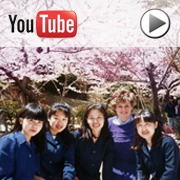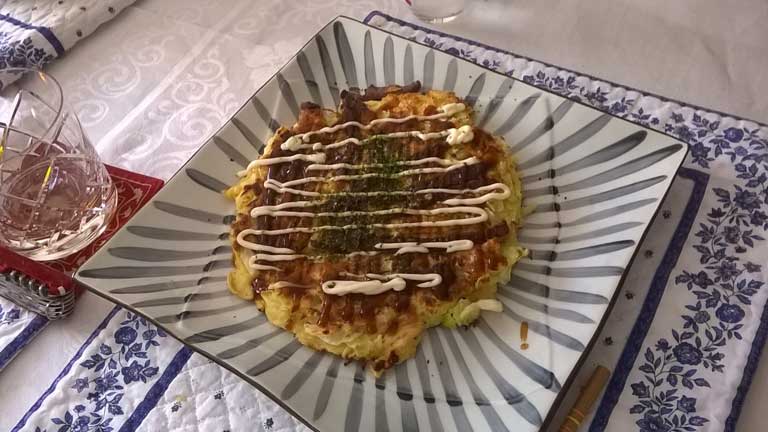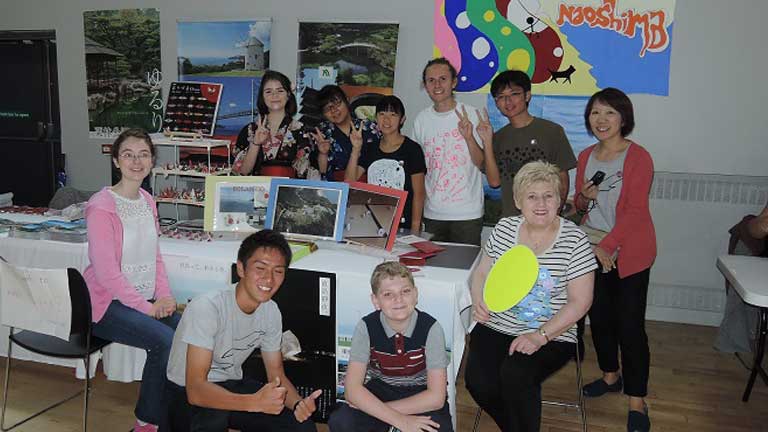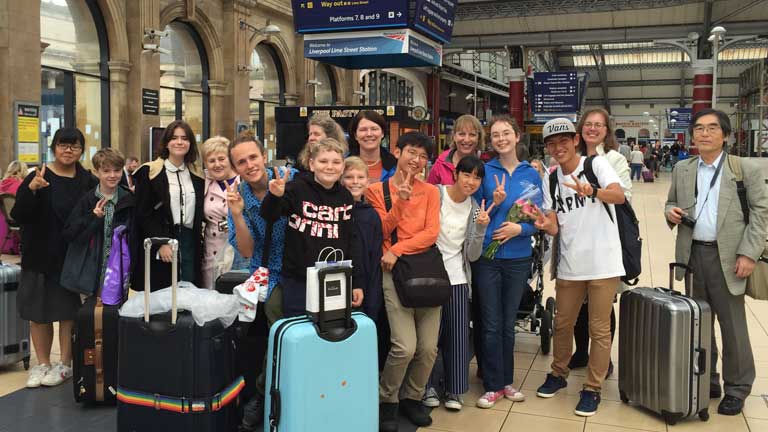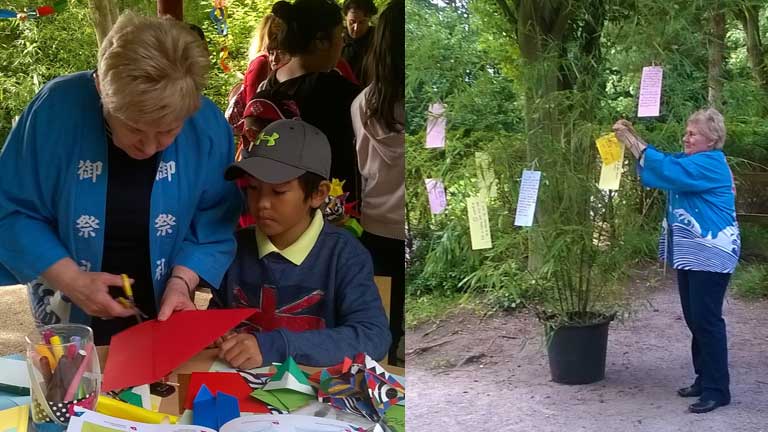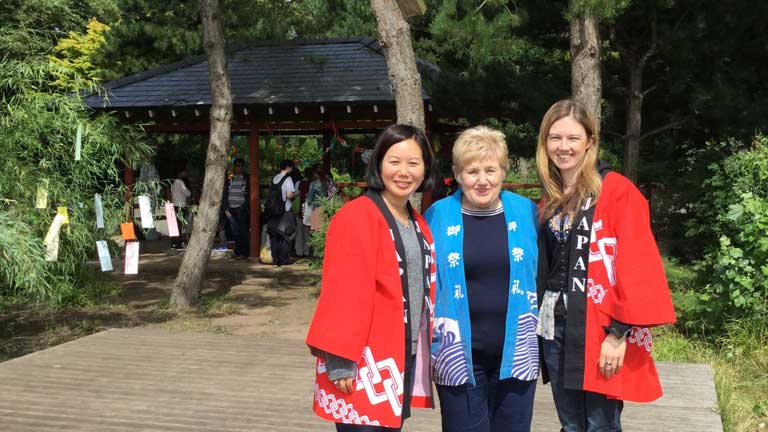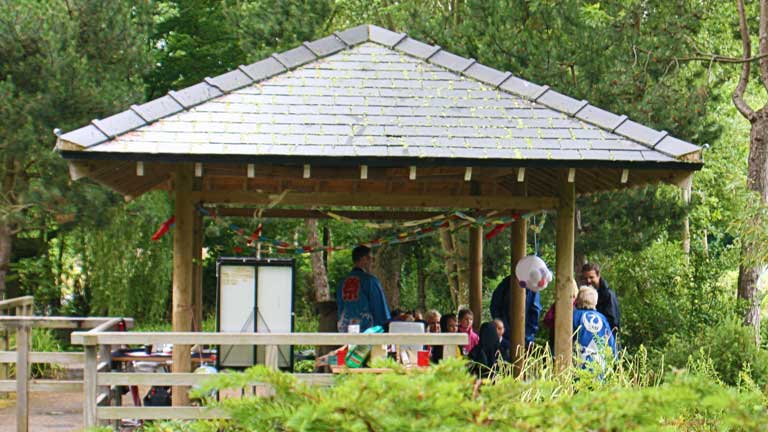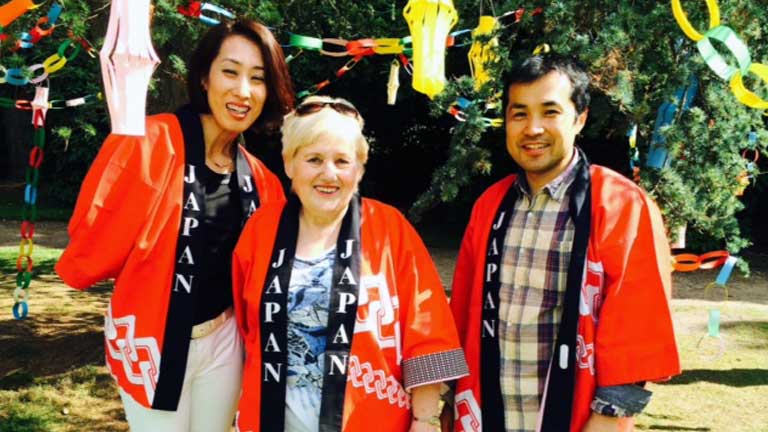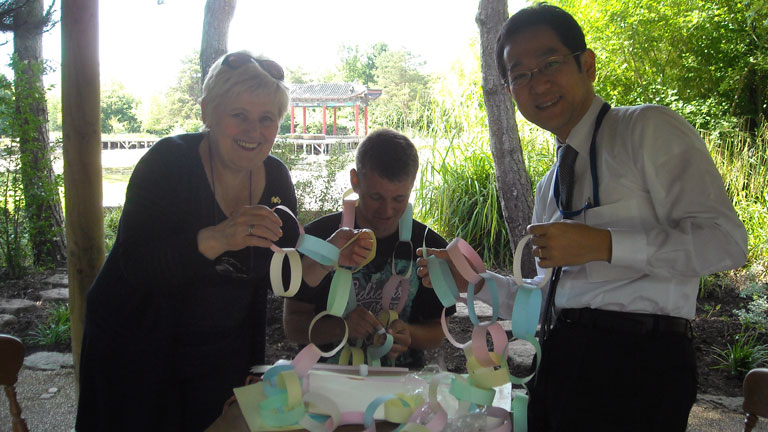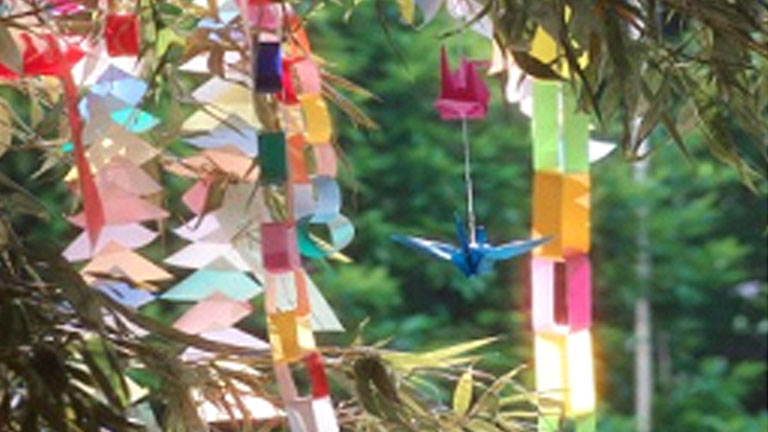
Co-ordination Services
Coordinating work involves contacting each of the parties involved and translating documentation, letters and communications as well as interpreting at all meetings.
The types of project I have been involved include the following:
- Student Trip to Japan, October 2019
- Visit by Students from Naoshima, Japan - August 2018
- Tanabata August 2016
- Tanabata July/August 2015
- Japanese Garden Tanabata, July 2014
- Chelsea Flower Show
- Tatton Park in Knutsford, Cheshire
- Royal Botanic Gardens, Kew
Student Trip to Japan, October 2019
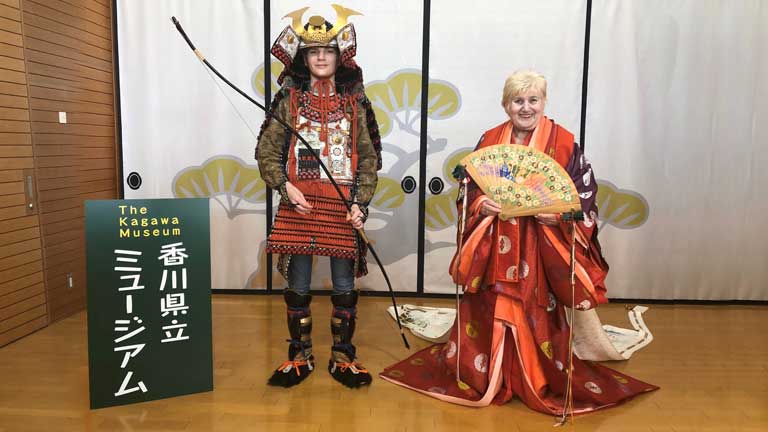 Angela took a very able student to Japan during the school half term October-November, and they had the pleasure of being dressed in formal historical attire. Both the helmet and Angela’s mock of 12 kimonos were extremely
heavy.
Angela took a very able student to Japan during the school half term October-November, and they had the pleasure of being dressed in formal historical attire. Both the helmet and Angela’s mock of 12 kimonos were extremely
heavy.
Visit by Students from Naoshima, Japan - August 2018
In 2014 Angela met up with her friend and colleague Mrs. Michiko Hamanaka (Hamanaka Sensei) with whom she worked on Naoshima Island in 2003 and has met every year since. Hamanaka Sensei told me she was planning to bring some High School students over to the UK for the first time from Naoshima. She had seen the report about Japan Day 2014 and thought it would be great to incorporate the visit with Japan Day in 2016.
Angela met with her and the Director of Education Mr. Hara, again in April this year (2016) to finalise the details.
The plan was to bring 4 high school students (in the end one came from a Junior High School) to stay with local families and see the historic city of Liverpool for a 4 day visit, and also take part in Japan Day.
Angela was already taking a table at Japan Day to promote Kagawa Prefecture and so she organised another table next to hers for the students and teachers from Naoshima. In fact Naoshima belongs to the Prefecture of Kawaga.
Angela met Hamanaka sensei and the students at Lime Street station on the 18th August together with Callum, the retiring ALT from Naoshima who accompanied them, and all went off to meet with the home stay families, and go home with them. These were families of Angela’s current and former students of Japanese who kindly agreed to take a student for the 4 day period.
On Friday morning, the weather had unfortunately changed for the worse, but, undaunted, everyone met up at the Pierhead for a city tour on a City Tours hop-on-hop-off bus who had kindly given us a big discount. Despite the miserable weather everyone enjoyed themselves especially at the Museum in William Brown Street and the cathedrals.
In the evening each student made ‘okonomiyaki’ for their home stay family. Hamanaka sensei and Callum made some for Angela too…delicious!
On Saturday everyone got to Liverpool University in good time to set up the Kagawa and Naoshima tables for Japan Day. It was a very busy day all day, and the students, in addition to giving out badges and magnets they had made, demonstrated origami and Japanese calligraphy to a very keen number of visitors. The Director of Education from Naoshima had arrived on Friday night and he took part and enjoyed Japan Day very much.
The home stay families gave great support both on the Friday and Saturday and after Japan day, Naoshima Education Department treated everyone to a delicious dinner at Etsu.
Sunday was a day that the students spent entirely with their home stay family and on Monday morning everyone met again at Lime Street station for some sad farewells.
Tanabata August 2016
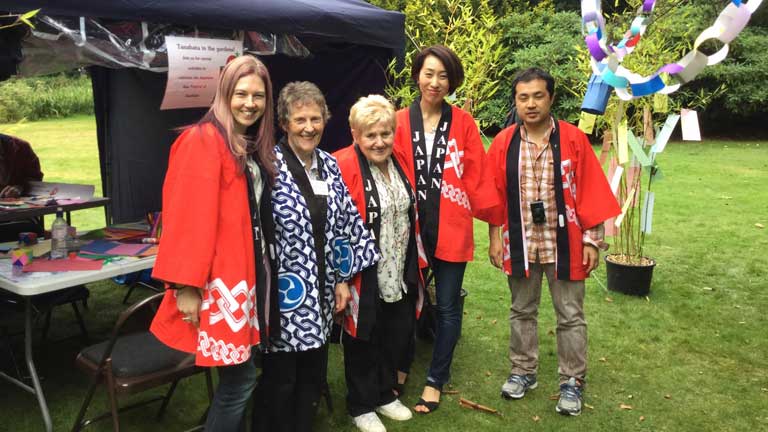 Tanabata, or the Star Festival, was coordinated again in August 2016 By Angela at the request of and with the support of the Japanese Embassy.
Tanabata, or the Star Festival, was coordinated again in August 2016 By Angela at the request of and with the support of the Japanese Embassy.
On 13th August at Liverpool’s Festival Gardens the site of a Japanese garden and on August 27th at Tatton Park in Cheshire.
Representatives from the Japanese Embassy came up to Liverpool and Manchester and gave their support with the making of paper decorations and origami, and Japanese calligraphy. Wishes were written on Tanzaku by children and adults which they hung on bamboo branches in the gardens.
Tanabata July/August 2015
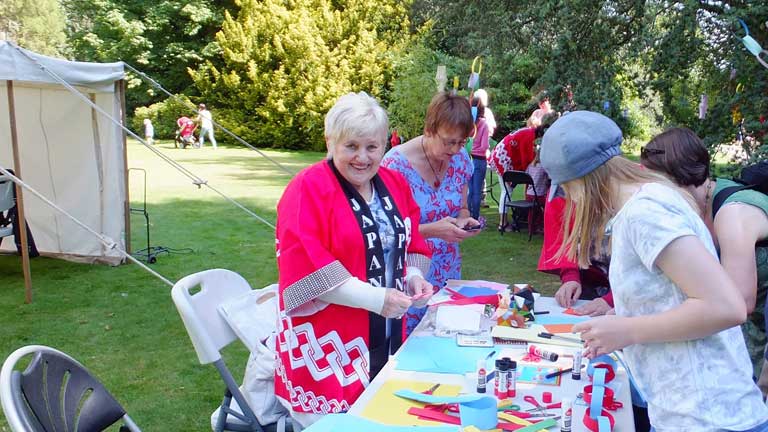 Tanabata, or the Star Festival, traditionally is held on the evening of 7 July throughout Japan although it can be held between that date and the 7th August. The festival traces its origins to a romantic legend that the Cowherd Star (Altair) and Weaver Star (Vega), lovers separated by the Milky Way, are allowed to meet just once a year on the seventh day of the seventh month.
Tanabata, or the Star Festival, traditionally is held on the evening of 7 July throughout Japan although it can be held between that date and the 7th August. The festival traces its origins to a romantic legend that the Cowherd Star (Altair) and Weaver Star (Vega), lovers separated by the Milky Way, are allowed to meet just once a year on the seventh day of the seventh month.
Young people and old, write their on narrow strips of coloured paper called tanzaku and hang them, along with other paper ornaments, on bamboo branches placed in the backyards or entrances of their homes or at on bamboo placed especially for the purpose in designated garden and/or park sites
They then pray hard in the hope that their wishes will come true. Towns and cities take on a festive mood during the Tanabata season, with colourful decorations.
2014 was the first time the running of Tanabata festivals was held in Japanese style gardens in the U.K. The suggestion came from the Embassy of Japan in London and Angela Davies coordinated the festival in four gardens, three in the Northwest and one at Kew. The gardens chosen in the North West were the Liverpool Festival site, Tatton Park in Cheshire, and the Japan Garden Society’s garden at Walkden gardens in Sale.
This year too the festival was organised at Liverpool’s IGF site and at Tatton Park in Cheshire.
Representatives from the Embassy came up to Liverpool and Manchester and gave their support with the making of paper decorations and origami. Wishes were written on Tanzaku by children and hung on bamboo branches in the gardens.
Japanese Garden Tanabata, July 2014
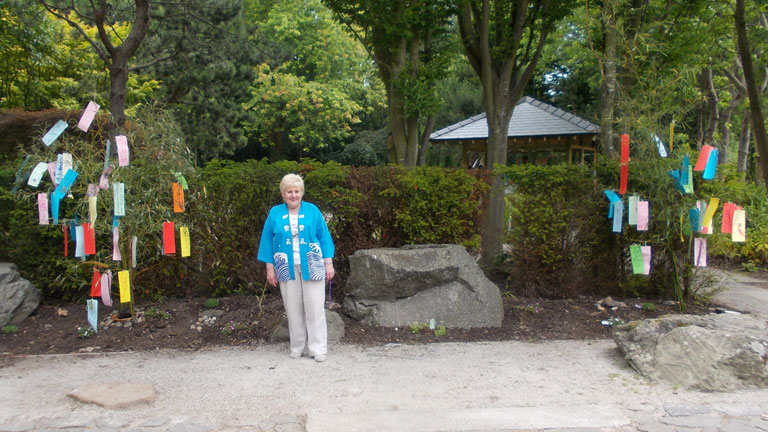 Tanabata, or the Star Festival, traditionally is held on the evening of 7th July throughout Japan although it can be held between that date and the 7th August. The festival traces its origins to a romantic legend that the Cowherd Star (Altair) and Weaver Star (Vega), lovers separated by the Milky Way, are allowed to meet just once a year on the seventh day of the seventh month.
Tanabata, or the Star Festival, traditionally is held on the evening of 7th July throughout Japan although it can be held between that date and the 7th August. The festival traces its origins to a romantic legend that the Cowherd Star (Altair) and Weaver Star (Vega), lovers separated by the Milky Way, are allowed to meet just once a year on the seventh day of the seventh month.
People, especially children, write their wishes such as “I want to become good at football” or “I want to become an astronaut” on narrow strips of coloured paper called tanzaku and hang them, along with other paper ornaments, on bamboo branches placed in the backyards or entrances of their homes or at on bamboo placed especially for the purpose in designated garden and/or park sites.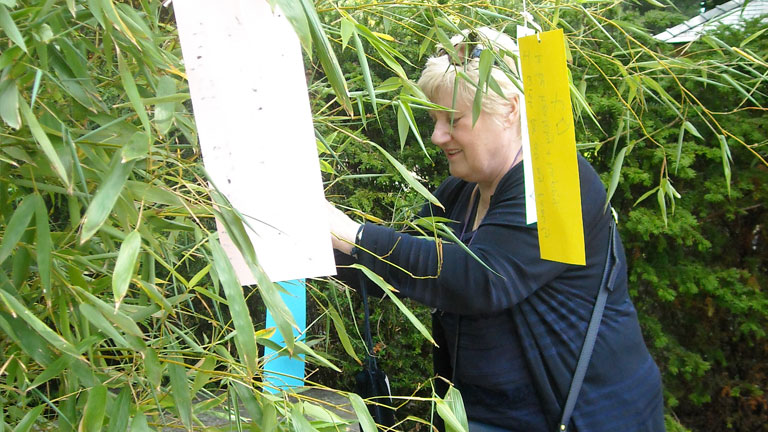 They then pray hard in the hope that their wishes will come true. Towns and cities take on a festive mood during the Tanabata season, with colourful decorations.
They then pray hard in the hope that their wishes will come true. Towns and cities take on a festive mood during the Tanabata season, with colourful decorations.
This year 2014 was the first time to organise a co-ordinated approach to running Tanabata festivals in the UK. The suggestion came from the Embassy of Japan in London and was co-ordinated by Angela Davies in four gardens, three in the Northwest and one at Kew. The gardens chosen in the North West were the Liverpool Festival site, Tatton Park in Cheshire, and the Japan Garden Society’s garden at Walkden gardens in Sale.
At the Liverpool Festival site Angela worked with Mr Suzuki from the Embassy in making paper decorations. Tanzaku were created by children and hung on bamboos in the garden.
Tatton Park opted not to hold their festival in Tatton Park itself but in the centre of Manchester at their garden in the Dig-the-City Garden Festival. Angela gave support to the Embassy representatives despite the pouring rain got interested members of the public to write wishes on Tanzaku. They were tied to several bamboo plants that Tatton Park gardeners had placed adjacent to their DIY dry stone garden, which was sponsored by the Japan Garden Society.
Chelsea Flower Show
 At the same time as this project was taking place she was involved in another one to create a Japanese garden at the Chelsea Flower Show as part of Japan 2001.
At the same time as this project was taking place she was involved in another one to create a Japanese garden at the Chelsea Flower Show as part of Japan 2001.
For this project between 2000~2001 she was chosen as the coordinator between the Daily Telegraph, the UK sponsor, the Team for the Japanese Garden, which was a combination of Japanese sponsors headed by the Urban Green Space Foundation, the Japanese Embassy, the designer and the landscapers.
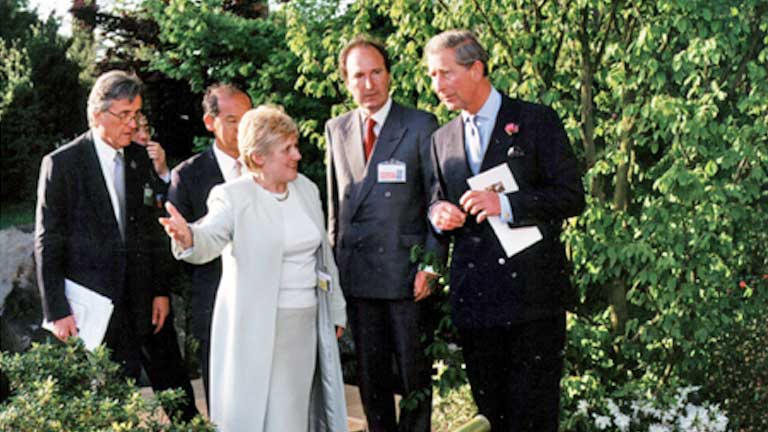 This garden won gold and was awarded ‘Best in Show’.
This garden won gold and was awarded ‘Best in Show’.
Later that year she was awarded the prize for International Relations by the Urban Green Space Foundation.
Following the end of the Chelsea Flower Show that year, it was considered that the garden was too beautiful just to break it up and so following negotiations between the Japanese Embassy and the National Botanic Garden of Wales, and she was brought in to coordinate the transfer and re-construction of this garden at those Botanic Gardens in Llanarthe later in 2001.
Tatton Park in Knutsford, Cheshire
 Following on from that she again coordinated a project to restore the Japanese garden at Tatton Park in Knutsford, Cheshire.
Following on from that she again coordinated a project to restore the Japanese garden at Tatton Park in Knutsford, Cheshire.
The restoration work for the Japanese garden was undertaken with the co-operation of the Organisation for Landscape and Urban Greenery Technology Development in Japan, following a request from the National Trust for assistance to restore the garden. In July 1999 a survey of the garden was carried out, and she was involved in coordinating the project between the OLUGTD, the National Trust, Tatton Park and the designer and the landscapers. The work was completed in May 2001.
This garden holds an extremely important significance from the point of view of Anglo-Japanese garden history, and the project was not simply to restore the garden to its original form, but was a reconfirmation of the garden’s history as well as the history of cultural exchanges between the UK and Japan.
Royal Botanic Gardens, Kew
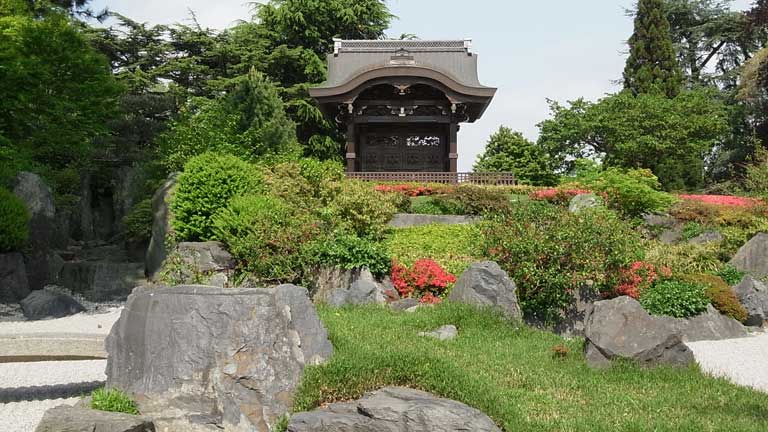 In 1990 Angela was asked by the Japanese Government to take on a role in charge of foreign affairs at the Japanese Government exhibit during the International Garden and Greenery Exposition in Osaka in 1990. Following that she was retained in the UK as a commissioned representative for the Organisation for Landscape and Urban Greenery Technology Development (OLUGTD). During the years she was with this organisation she coordinated numerous visits by landscapers and town planners not only to the UK but throughout Europe when she accompanied the groups acting also as their interpreter.
In 1990 Angela was asked by the Japanese Government to take on a role in charge of foreign affairs at the Japanese Government exhibit during the International Garden and Greenery Exposition in Osaka in 1990. Following that she was retained in the UK as a commissioned representative for the Organisation for Landscape and Urban Greenery Technology Development (OLUGTD). During the years she was with this organisation she coordinated numerous visits by landscapers and town planners not only to the UK but throughout Europe when she accompanied the groups acting also as their interpreter.
From 1994-1998 she coordinated a project between the OLUGTD, the Royal Botanic Gardens, Kew and the Japanese Embassy to accomplish the restoration of a Japanese gateway called the Chokushi-mon that had been presented to Kew in 1910 (It was a 4/5-scale reproduction of the Kara-mon gateway at Nishi Hongan-ji Temple in Kyoto). It had been placed at the entrance to the Kyoto pavilion as one of the Japanese exhibits of the Anglo/Japanese exhibition held in London in 1910. 83 years after being transferred to Kew, the extent of deterioration and damage to the gateway had become extremely serious and between October 1994 and November 1995 a project to restore it was undertaken.
Following the restoration of the gateway the second stage of the project was the construction of a Japanese garden area around the restored Chokushi-mon gateway and plans were put in place for a joint Anglo-Japanese project to build a Japanese garden that would be universally respected as highly traditional, and also deepen the friendship and co-operation existing between the two Countries.
In 1999 Angela was awarded the International Sato Prize for her work in coordinating this project.

